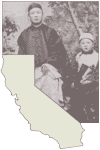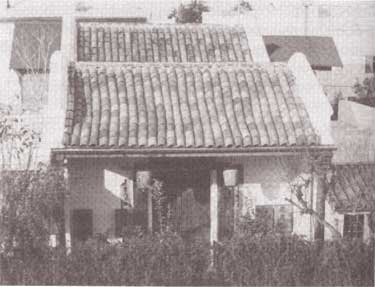![]()

Five Views: An Ethnic Historic Site Survey for California
MENU
Introduction
Early Contacts
1850s
1860s
1870s
1880s
1890s
1900s
Historic Sites
Selected References

A History of Chinese Americans in California:
HISTORIC SITES
Bok Kai Temple
Marysville, Yuba County
The Bok Kai Temple, located in Marysville, is a brick building with a double gabled roof. Its walls are plastered white, and the roof is covered with mission tiles. The building faces south, and is built so close to the levee that the main approach to the front of the building is down a flight of steps from the top of the levee. The levee is almost the same height as the building itself.
The facade is divided into three parts, with a central door painted red. The porch is covered by an overhanging roof, the ends of which are supported by two turned wooden columns, also painted red. Under the eaves are paintings of religious scenes. On either side of the door are Chinese inscriptions carved in wood and painted gold on a red back ground. The porch has a traditional Chinese wooden railing.
Inside the temple are statues of seven deities, five on the main altar with Bok Eye (Bok I or Bok Aie, god of the north) in the center, and two on separate altars. In front of the main altar on a long table are a brass tablet bearing inscriptions of the deities, incense burners, divination sticks, oracle books, and other ceremonial objects. The temple also has two wings, both with flat roofs. The west wing is a council room. The east wing is a storeroom. Living quarters have been added to the northeast corner of the building.
The Bok Kai Miu is the only surviving Taoist temple in the United States with Bok Eye, the god of the north, as the central deity. It is, however, not the only Taoist temple in the United States honoring Bok Eye. Bok Eye is one of the deities in Weaverville's Won Lim Miu, for example. At Weaverville and elsewhere, Kuan Kung rather than Bok Eye is the central deity.
Kuan Kung was the most popular among early immigrants from Canton because he was once a living person (a military hero around 184 A.D.) who exemplified not only military valor but loyalty and high principles. He was replaced as the central deity in Marysville because the town was subjected to flooding, and Bok Eye, god of the north, controls the waters, including floods and irrigation. Situated on the lowlands at the bend of the Yuba River, the Chinese American community was especially endangered by flooding.
Because of discriminatory legislation, early Chinese pioneers were not allowed to become citizens or to own land. They had to live on land that no one else wanted, often land subject to flooding. Numerous Chinese American communities in the nineteenth century were destroyed by floods in which the inhabitants lost everything they owned. Harsh economic necessity forced them to face this danger, and the protection of Bok Eye helped them to do so.
The first Bok Kai Miu was built in Marysville about 1854, near the corner of First and B streets. It was said to have been made of wood and furnished with elaborate temple appointments made in China. According to Wells, Chinese Temples in California, it was probably destroyed by the 1866 flood, which was so severe that it forced most residents of the town to take refuge on the Sutter Buttes. If this was so, Marysville's Chinese American population would have been without a temple for 14 years. Other sources say that the first temple gradually fell into a state of disrepair.
The present Bok Kai Miu was built early in 1880, and dedication ceremonies were held March 28, 1880. Since that date, is has been in continuous operation. It is one of the oldest Taoist temples in California still serving the community with an official to assist in religious services.
It also is the only temple in the United States that still celebrates Yee Yeut Yee ("Bomb Day"), a holiday honoring Bok Eye. In the nineteenth century, this holiday was widely celebrated at temples from Grass Valley to Yreka in Northern California.
"Bomb Day" derives its name from the shooting off of bombs which contain "good fortune" rings. The two-day holiday begins quietly with religious observances on the first day, and ends with the bombs and a parade featuring the Golden Dragon.
Marysville's dragon was said to have been the first one brought to this country, sometime before the turn of the century. It was more than 150 feet long, and required about 100 men to carry it. It was exhibited at the World's Fair in New York, and was last used in the 1937 parade in Marysville. "Bomb Day" (now with a newer, shorter dragon in its parade) is still an annual event in Marysville, celebrated not only by the city but by visitors from distant places.
The Bok Kai Temple is listed on the National Register of Historic Places and as a California State Historical Landmark.

Bok Kai Temple, Marysville, Yuba County
NEXT> Brookside Winery
Last Modified: Wed, Nov 17 2004 10:00:00 pm PDT
http://www.cr.nps.gov/history/online_books/5views/5views3h11.htm
![]()
 Top
Top